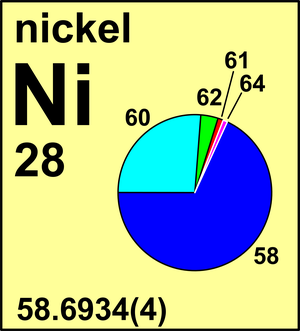Molar Mass, Molecular Weight and Elemental Composition Calculator
Molar mass of Ni(CO)4 is 170.7338 g/mol Convert between Ni(CO)4 weight and moles
Elemental composition of Ni(CO)4
Sample reactions for Ni(CO)4
Formula in Hill system is C4NiO4 | ||||||||||||||||||||||||||||||||
Computing molar mass (molar weight)To calculate molar mass of a chemical compound enter its formula and click 'Compute'. In chemical formula you may use:
Molar mass calculator also displays common compound name, Hill formula, elemental composition, mass percent composition, atomic percent compositions and allows to convert from weight to number of moles and vice versa. Computing molecular weight (molecular mass)To calculate molecular weight of a chemical compound enter it's formula, specify its isotope mass number after each element in square brackets.Examples of molecular weight computations: C[14]O[16]2, S[34]O[16]2. Definitions of molecular mass, molecular weight, molar mass and molar weight
Give us feedback about your experience with Molecular Weight Calculator. Related: Molecular weights of amino acids | ||||||||||||||||||||||||||||||||
| molecular weights calculated today | ||||||||||||||||||||||||||||||||
| Back to Online Chemical Tools Menu |
© 2021 webqc.org All rights reserved
- Nickel has a lower atomic mass than cobalt, even though it has a higher atomic number. One possible explanation is that one of the average atomie masses was miscalculated. In the case off cobalt, there is only one isotope: 100% 5'Co at given in the table. Isotope mass (amu) Abundance 5Ni Ni Ni mass of 58.9332 amu.
- The atomic mass is useful in chemistry when it is paired with the mole concept: the atomic mass of an element, measured in amu, is the same as the mass in grams of one mole of an element. Thus, since the atomic mass of iron is 55.847 amu, one mole of iron atoms would weigh 55.847 grams.
| Periodic table |
| Unit converters |
| Chemistry tools |
| Chemical Forum |
| Chemistry FAQ |
| Constants |
| Symmetry |
| Chemistry links |
| Link to us |
| Contact us |
How to cite? |
WebQC.Org online education free homework help chemistry problems questions and answers |
The USA 5-cent coin (whose nickname is 'nickel') contains just 25% nickel. Nickel is a silvery white metal that takes on a high polish. It is hard, malleable, ductile, somewhat ferromagnetic, and a fair conductor of heat and electricity. Nickel carbonyl, Ni(CO) 4, is an extremely toxic gas and exposure should not exceed 0.007 mg M-3.
Molar mass of Ni = 58.6934 g/mol
Convert grams Nickel to moles or moles Nickel to grams
| Symbol | # of Atoms | Nickel | Ni | 58.6934 | 1 | 100.000% |

Note that all formulas are case-sensitive.Did you mean to find the molecular weight of one of these similar formulas?
NI
Ni
Atomic Mass Of Nickel Ii Chloride
Nickel (Ni), a transition metal with an atomic weight of 58.69 and an atomic number of 28, is usually recognized by its silvery shine with a hint of gold color. It was first discovered by Axel Fredrik Cronstedt in 1751 and named nickel from the ore 'kupfernickel'. So to figure out the mass of neutral nickel 60 we know that 1 a.m. Is equal to about 1.66 times 10 to the negative 27 kilograms and then in nickel 60 we have 59.93 a. And so the total mass in kilograms is going to be about 9.95 times 10 to the negative 26 kilograms.
In chemistry, the formula weight is a quantity computed by multiplying the atomic weight (in atomic mass units) of each element in a chemical formula by the number of atoms of that element present in the formula, then adding all of these products together.
The atomic weights used on this site come from NIST, the National Institute of Standards and Technology. We use the most common isotopes. This is how to calculate molar mass (average molecular weight), which is based on isotropically weighted averages. This is not the same as molecular mass, which is the mass of a single molecule of well-defined isotopes. For bulk stoichiometric calculations, we are usually determining molar mass, which may also be called standard atomic weight or average atomic mass.
Finding molar mass starts with units of grams per mole (g/mol). When calculating molecular weight of a chemical compound, it tells us how many grams are in one mole of that substance. The formula weight is simply the weight in atomic mass units of all the atoms in a given formula.
Mass Of A Nickel
If the formula used in calculating molar mass is the molecular formula, the formula weight computed is the molecular weight. The percentage by weight of any atom or group of atoms in a compound can be computed by dividing the total weight of the atom (or group of atoms) in the formula by the formula weight and multiplying by 100.
A common request on this site is to convert grams to moles. To complete this calculation, you have to know what substance you are trying to convert. The reason is that the molar mass of the substance affects the conversion. This site explains how to find molar mass.
Formula weights are especially useful in determining the relative weights of reagents and products in a chemical reaction. These relative weights computed from the chemical equation are sometimes called equation weights.
Using the chemical formula of the compound and the periodic table of elements, we can add up the atomic weights and calculate molecular weight of the substance.
